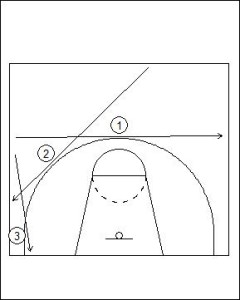Half Court Man-to-Man Defence Principles: Where to Push the Offensive Player
Heard of the Half Court Man-to-Man Defence? I am sure you have, as along with the 2-3 Zone Defence it is really the bread and butter of the majority of basketball teams on the planet. Understanding and having clear expectations about the Half Court Man-to-Man Defence rotations is one thing; this information can be found on most good basketball coaching websites across the internet. However, what is less than easy to find is where to push or channel the offensive player to by the defensive match-up.
The Man-to-Man Defence places the defensive players into a one on one match-up. They often have a specific individual offensive player who is their responsibility to manage and contain, before finally boxing out. At its simplest, this might really be the job description of each individual player within the Man-to-Man Defence.
When guarding the ball in the Man-to-Man Defence system a player is really matching their fundamental individual defensive skills against those of the offensive player. However, on a deeper level of the Man-to-Man Defence is all about the help rotations off the ball. This is really where we start to think about five defensive players all working together to stop the basketball, not their individual match-ups.
For these rotations to be effective, each individual defensive player when matching up with the ball handler must look to push their match-up in specific directions, to designated positions where the Man-to-Man Defence can come into play in its natural rotations and play to its strength in numbers. If the rotations are practiced and refined during training sessions then during games the Man-to-Man Defence will be effective and exacting. If players forget to move because they are not focused, do not understand the defence, or are just plain lazy then the Man-to-Man Defence becomes a one on one free for all.

In the diagram above the direction of where to push players are displayed with reference to the starting position of the offensive player. In the Point Position (One) at the top of the key, the offensive player should be pushed towards the sideline in an imaginary line parallel to that of the baseline. In the diagram, the default direction is highlighted as a movement towards the left hand side of the court. This is a deliberate strategy. If there is no scouting about the team or the individual players, a safe bet is that less players will have their left hand as their dominate hand in comparison to the right hand. For this reason when short on scouting information a team should look to automatically channel to the left-hand side of the court and in so doing put the ball into the non-dominate hand of the offensive players.
An additional added benefit is that most coaches tend to start their offensive structures with the ball or player movement starting on the right hand side of the floor. So pushing the ball away automatically makes players feel uneasy about how the offense will begin and in some cases can severely limit the offensive options.
When the ball is with Two (2) the defence wants to push the offensive player towards the sideline. In some defensive systems this position is often discussed as pushing Two (2) towards the baseline. But this mindset is really giving this ground far too easily to the offensive player. It should be first discussed that the offense is pushed towards the sideline with the recovery to the baseline if needed. By doing this we challenge the defence to do more than just be a passenger in containing ball movement to the middle of the floor. A good defensive player should be able to deny the middle of the floor and also contain the baseline attack enough that the offensive player has to at least flare on their drive to the short corner.
Finally, in the long corner position (Three) the defence wants to really use the sideline and baseline as additional defenders and isolate the offensive player is this remote part of the court.
Within the Man-to-Man Defence, there are of course a number of variations that can be undertaken by a coach in choosing where they would like to push or channel a ball towards. The above principles have been highlighted as “food for thought” in regards to what your own defensive philosophy should, or could look like. No defensive system is perfect, but there is something to be said for a team that has its own style or identify of play on defence. Upon this “defined” type of defensive system, a team can build a reputation, pride, responsibility, and accountability.








Leave a Reply